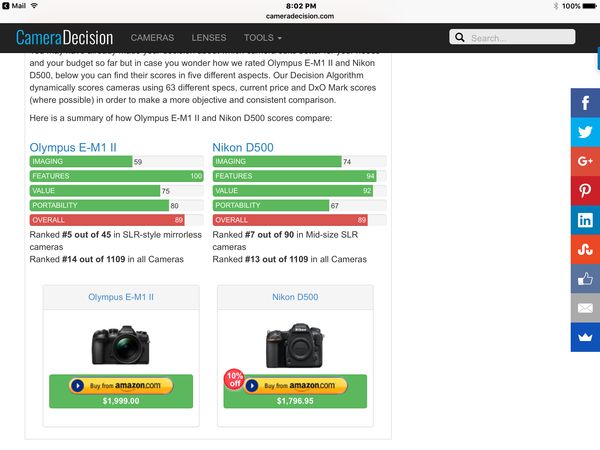Recommendations for sports camera
May 22, 2017 20:04:46 #
And even holds its own against the high and mighty d500. All that with a "tiny" sensor.
May 22, 2017 20:16:02 #
CHOLLY wrote:
AGAIN, you include in your post that image stabili... (show quote)
I'm sorry, and with all due respect, if you're disagreeing with me that the goal of IS/VR is to allow a lower shutter speed to ameloriate camera shake blurring the image, then it is you that doesn't understand stabilization. You may call it a square, a triangle, or whatever you wish, but if you use IS/VR to lower shutter speed with a relatively motionless subject, then to maintain the correct exposure, you must either lower ISO or decrease the aperture to maintain the same exposure. You can't possibly disagree with that, can you??? iS/VR is designed to lower shutter speed to ameliorate camera shake - period. Any attendant changes in ISO or aperture are a secondary result of that primary goal. Did you read the B&H article I referenced? Blurring due to camera movement can only be addressed by keeping the camera steadier (tripod), or raising the shutter speed. Please read the referenced article and any other source you wish on stabilization, and if you still don't agree (sigh), then reference the article that proves your position. Frankly, I can't believe you're arguing this point.
But the real point that's relavent to this thread is that IS/VR has very limited/no usefulness when shooting fast moving subjects at high shutter speed such as sports because you're using a high enough shutter speed that camera shake is not an issue. In fact, many shooters disable it under those conditions as it can slow down AF. Do you disagree with that?
Regarding your other comments, since I've been shooting for well over 50 years including a number of years shooting sports (and 4 of my current lenses have IS), I believe I speak from experience, not theory. If you want to debate the point, how about limiting yourself to real references and logical thought rather than decending to ad hominem attacks. I am respectfully disagreeing with you. I feel sure you are an experienced photographer even though your ideas concerning IS are at odds with the facts, and if you wish to continue the discussion, please extend me the same respect.
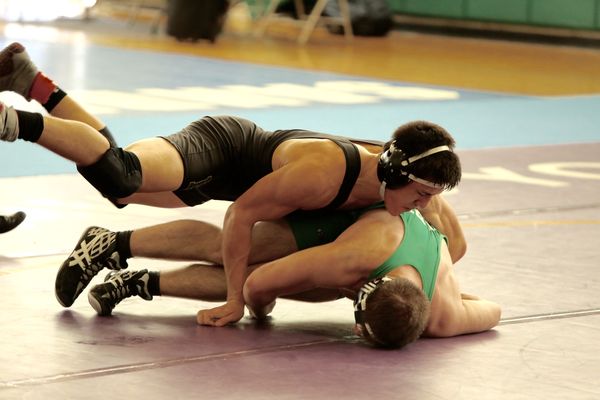
May 22, 2017 20:33:09 #
CHOLLY wrote:
Actually, the FIRST qualifier the OP should have p... (show quote)
You're a bit off on your dates. The 7D2 was introduced in september 2014, so it is 2 years and 8 months old - not 5. Please stick to the facts.
You are certainly correct that budget is a qualifier, because successfully shooting indoor sports can be expensive, both in terms of bodies and lenses. I would posit that if you want the perfect cost-no-object sports camera, then the current gold standard is a 1DX Mk2 or a D4 or D5, and the majority of pros are shooting something similar. The A9 may be a contender, and time will tell. I am not demeaning Sony or mirrorless products (or any others). There are many great cameras available today that will do the job - it was you that started the partisan (and misguided) anti-Canon rant. I'm just adding some balance here.
May 23, 2017 00:08:59 #
Actually, if you are just starting out, and don't have any equipment, I would go find a good used D300, a used 17-50 2.8 and a used 80-200 2.8. You can put that all together for less than a new body AND while the bells and whistles on the new cameras may make the job easier, you have more than enough to turn out high quality images even in the dark hole of Calcutta, if you learn how to use the camera. A monopod is far more useful for sports than image stabilization. Learning to capture the peak of action with a single click is far more important than wasting 10 frames a second. You can learn everything you need to learn from that equipment, and then if in six months you decide that it's not your cup of tea, you will still be able to sell the equipment for at least close to what you paid for it. On the other hand, if you go top end, in six months you will take a bath on what you paid because while you can ask near new price, the reality is that you will be lucky to get half of what you paid.
May 23, 2017 00:44:04 #
TriX wrote:
I'm sorry, and with all due respect, if you're dis... (show quote)
With all due respect, not ONCE did I claim what you infer... that image stabilization is NOT for camera shake. What I DID say... QUITE CLEARLY AND REPEATEDLY... is for a given exposure value, that Image Stabilization allows you to shoot at a LOWER ISO.
Why did I make those statements?
Because YOU initially claimed a numerical advantage in cankon lenses over Sony A/E mount lenses. I then correctly pointed out two critical facts; that the list of Sony A/E mount lenses cover ALL of the focal lengths, quality, and price points necessary for everything INCLUDING sports photography, and that in body image stabilization negates that canikon numerical advantage because EVERY lens on a modern A/E mount body is stabilized.This is in comparison to a relatively few, expensive IS/VR canikon lenses. At which point YOU then decided to launch the whole "IS/VR does nothing at higher shutter speeds" canard. I say canard because in EACH of your explanations to back that up, you mentioned that IS/VR allows you to shoot at a SLOWER SHUTTER SPEED WITH ATTENDANT REDUCTION IN ISO.
As Homer Simpson would say... "D'OH!!!"
Again... and with all due respect... you seem to be totally discounting the very data YOU keep introducing into this discussion; that shooting sports inside USUALLY means poor to average lighting... conditions that when trying to freeze the action, require you to shoot at both wide apertures AND high ISO to increase shutter speed.
Image Stabilization allows you to do exactly that. You do understand something you yourself have said REPEATEDLY, don't you? I hope so... because if not, then there is nothing I can do to help you.

Let me point one more thing out to you: although you have 4 IS lenses... every single one of my 36 lenses is Image Stabilized when used on my Sony bodies. From super wide angle to super telephoto... ALL OF THEM. Including the 32 year old Minolta AF lenses. And in my 50 plus years shooting, 40 as a trained photographer, that's a good thing.
Consider that.

May 23, 2017 00:58:35 #
TriX wrote:
You're a bit off on your dates. The 7D2 was introd... (show quote)
AGAIN, you are putting YOUR thoughts into what I actually printed. I never said a word about when the 7DII was introduced. I DID however, comment REPEATEDLY about the technology used to create it... technology that was in fact, FIVE YEARS OLD WHEN THE CAMERA WAS RELEASED.
The problem with MOST Canon owners is the insular lives you guys lead. You SEEM to be perfectly happy with minor tweaks to old technology and the concomitant HIGH price increases the company charges for them. Not only that, but a LOT of Canon guys are quick on the draw when it comes to "poo-pooing" advances made by other companies.
Well, consider this; mirrorless camera sales were flat last year (except for Sony which had a record year) while DSLR sales continue to plunge. Sony is already #2... and if Canon continues it's current practice of fleecing it's customer base for every penny... (do lens hood come with ALL your canon glass, or do you have to buy them separately?)... eventually some will see the light and LEAVE the dark side for that light. In 3 years you'll see black, white, and cream lenses at sporting events... just like you see more and more cream shooting weddings and graduations. Then the question that started this whole thread will be "mirrorless? YES!!!"

May 23, 2017 01:06:06 #
advocate1982 wrote:
Actually, if you are just starting out, and don't ... (show quote)
Hey... you DO realize that a monopod IS IMAGE STABILIZATION don't you?

And the days of HAVING to anticipate "peak action" for the shot are GONE.
IF you have ever shot sports, then you KNOW that anticipation doesn't always get that moment. And also, that there were equally important moments leading you to and immediately AFTER you pressed that shutter button to get your peak action shot.
THAT'S why the new A9 is such a game changer. Because it DOES shoot 20 frames per second... black out free... for 241 raw and 362 jpeg 24 megapixel images.
GAME CHANGER.

May 23, 2017 08:59:18 #
CHOLLY wrote:
With all due respect, not ONCE did I claim what yo... (show quote)
With respect, it is obvious that nothing I say is going to cause you to change your mistaken impression of the purpose and use of IS/VR, specifically for sports. So I'll just leave you this link in the hope that even if you don't read it, others may and understand the futility of using image stabilization with fast shutter speeds (that negate the blurring effects of camera shake) for sports. I am done - we will just have to agree to disagree. http://baselineshots.blogspot.com/2013/06/sports-photography-101-part-iv-image.html
May 23, 2017 10:00:54 #
CHOLLY wrote:
Hey... you DO realize that a monopod b IS IMAGE S... (show quote)
I've only shot sports for 40 years. It is all about catching the peak action, and your reflexs and timing are far more important than frame rate. I've sat in lots of media booths watching the frame rate kings bitching about missing the shot, while I can consistently get shots like these, Day in and day out, not by shooting high frame rates, but by putting myself in the right location, anticipating the action, and pressing the shutter button for a single exposure. And the added benefit, I don't have to be flipping through a dozen almost identical images trying to decide which of the missed photos is the better photo.
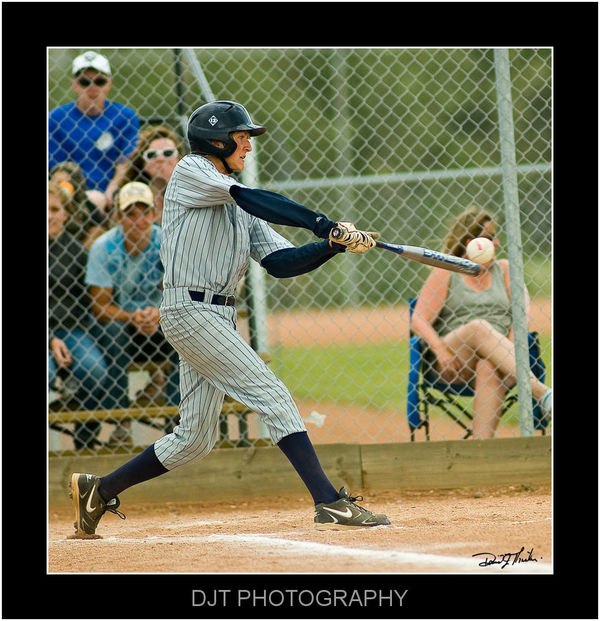
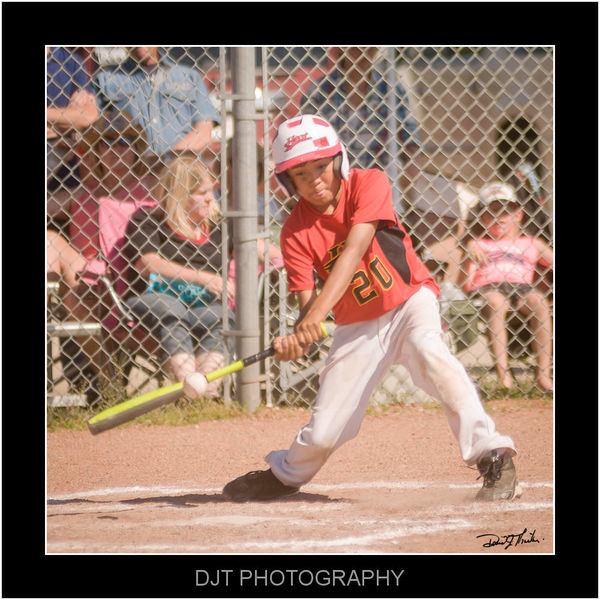
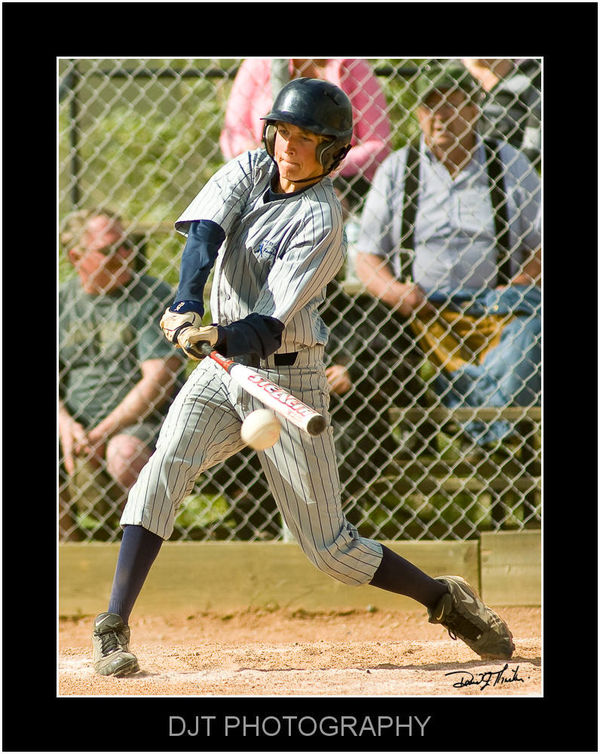
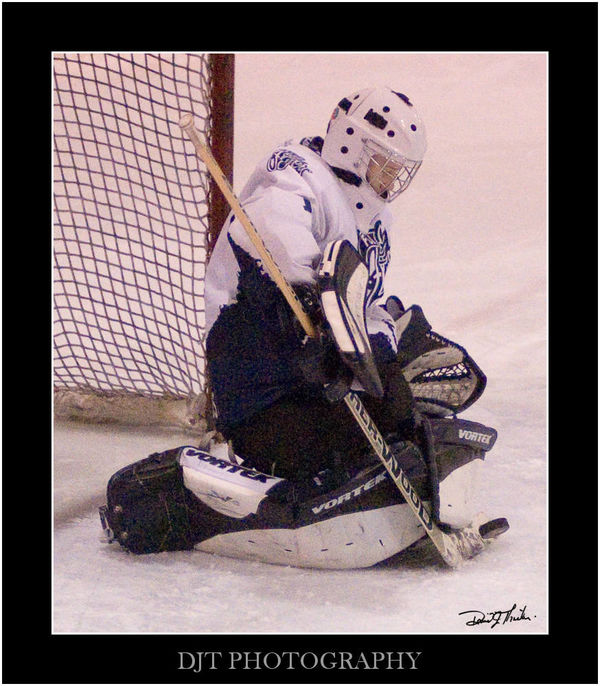
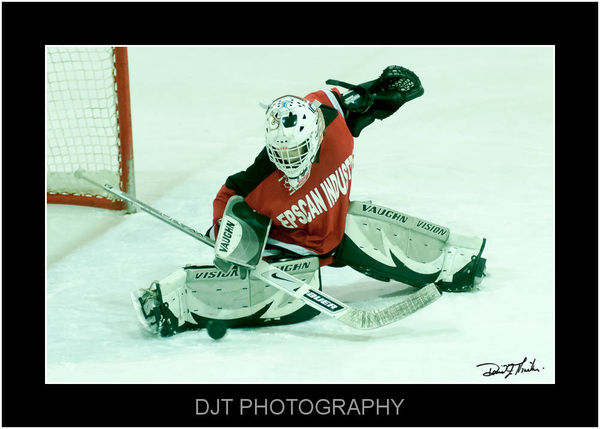
May 23, 2017 10:02:36 #
and these are mostly done with a D300 with the old 80-200 2.8 D, that push pull zoom that is slow to focus.
May 23, 2017 10:07:38 #
TriX wrote:
With respect, it is obvious that nothing I say is ... (show quote)
We can disagree 'till the cows come home... but that does NOT change the fact that you CLEARLY do not understand the relationship between Image Stabilization and ISO.
With In Body Image Stabilization on MY Sony camera bodies... I can use a LOWER ISO and STILL maintain not only shutter speed, but also maximum image quality.
And this is possible with ALL of my lenses... not just a handful of lenses with internal stabilization which I have never had the need to own.
AGAIN... this means that the so-called numerical advantage of Canikon lenses over Sony A/E mount lenses is effectively negated on modern Sony cameras... ESPECIALLY the A99II and the A9.
Have a wonderful day sir.

May 23, 2017 10:13:38 #
advocate1982 wrote:
I've only shot sports for 40 years. It is all abou... (show quote)
VERY nice collection.

Let me just say that with 20 frames per second of black-out free image capture, that you can catch the ball coming in AND off the bat... then you can pick the one with the greatest impact for publication.
BTW... there is NOTHING about 20 fps that prevents you from capturing the "peak action"... in fact, it allows you to capture nearly ALL of the peaks in the action... which is a good thing, and an EXTREMELY powerful tool in the hands of a photographer.

May 23, 2017 10:28:57 #
CHOLLY wrote:
VERY nice collection. img src="https://static.ugl... (show quote)
20fps...that's so slow. ;-)
May 23, 2017 10:51:21 #
CHOLLY wrote:
VERY nice collection. img src="https://static.ugl... (show quote)
But, I don't need more images. I only need one. And shifting through all those extras that are almost there, doesn't give me better images, it gives me less time.
May 23, 2017 11:03:30 #
Cdouthitt wrote:
20fps...that's so slow. ;-)
Show off!

But SERIOUSLY Clint, that 20 fps comes with FULL autofocus AND auto exposure... something that neither the 1DXII or the D5 can do at their maximum frame rates of 14 and 12 fps respectively.
And blackout free too?!?!
GAME CHANGER!!!

If you want to reply, then register here. Registration is free and your account is created instantly, so you can post right away.

